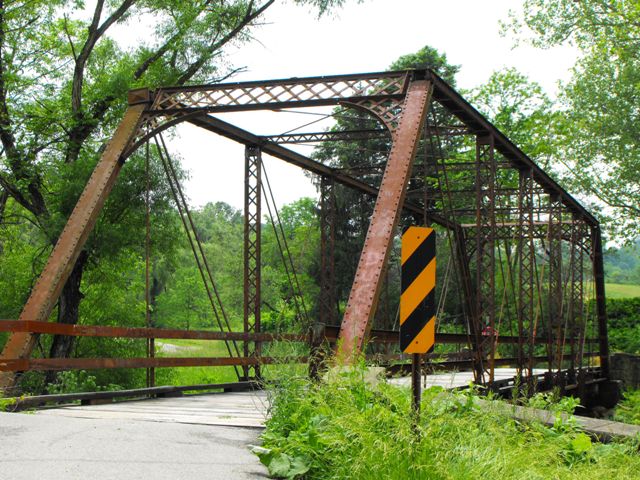We Recommend:
Bach Steel - Experts at historic truss bridge restoration.
BridgeHunter.com Phase 1 is released to the public! - Visit Now
Hodgens Bridge

Primary Photographer(s): Nathan Holth
Bridge Documented: June 1, 2010
Rural: Washington County, Pennsylvania: United States
1889 By Builder/Contractor: Penn Bridge Company of Beaver Falls, Pennsylvania
Not Available or Not Applicable
100.0 Feet (30.5 Meters)
103.0 Feet (31.4 Meters)
12.8 Feet (3.9 Meters)
1 Main Span(s)
62720204764029

View Information About HSR Ratings
Bridge Documentation
This bridge's future is at risk!
Bridge Status: Slated for demolition and replacement!View Archived National Bridge Inventory Report - Has Additional Details and Evaluation
This seven panel truss bridge is an excellent example of the unique and distinctive designs of the Penn Bridge Company. Most noteworthy is the detail that drives modern engineers nuts, which is that there are two pins (ie two connections) at the top chord / end post intersection where the hip vertical is located. Even though this unusual detail may not make sense to modern engineers, and may have not offered any advantage, the detail certainly has not kept the bridge from being able to serve vehicular traffic for well over a century. Another distinctive detail present on many Penn Bridge Company truss bridges is the way in which the top chord does not neatly meet up with the corner of the top of the end post. Instead, the top chord rests on top of the vertical member. Decorative cast iron covers for the top chord ends remain in place for only one of the top chords. Finally, another Penn Bridge Company detail is the tiny decorative medallions that are affixed to the knees of the portal bracing.
The bridge is historically and technologically significant for its unusual details that document the distinctive designs of a noteworthy Pennsylvania-based bridge company. The bridge retains good historic integrity with the exception of the bottom chord connections which have rather ugly modern metal beams bolted to the floorbeams and vertical members to bypass the connection. The good news is that these alterations appear to be reversible, and could be removed as part of a comprehensive restoration project.
Information and Findings From Pennsylvania's Historic Bridge InventoryDiscussion of Bridge The 104' long, pin connected Pratt through truss bridge built in 1889 is supported on ashlar abutments and flared wingwalls. The trusses are traditionally composed with the verticals being toe-out channels with laced webs. The stringers and deck are wood. The bridge stands out in a region with a deep and varied collection of metal truss bridges as one of the earliest. It also appears to be complete. The bridge is historically and technologically significant example of its type and design based on its date of construction and completeness. Discussion of Surrounding Area The bridge carries one lane of a township road over a stream in a rural area of active farms near the intersection of SR 221 and TR 476, north of Taylorstown. Scattered 20th century houses are in the area. Bridge Considered Historic By Survey: Yes |
![]()
Photo Galleries and Videos: Hodgens Bridge
Bridge Photo-Documentation
Original / Full Size PhotosA collection of overview and detail photos. This gallery offers photos in the highest available resolution and file size in a touch-friendly popup viewer.
Alternatively, Browse Without Using Viewer
![]()
Bridge Photo-Documentation
Mobile Optimized PhotosA collection of overview and detail photos. This gallery features data-friendly, fast-loading photos in a touch-friendly popup viewer.
Alternatively, Browse Without Using Viewer
![]()
Northbound Approach and Crossing of the Bridge
Full Motion VideoStreaming video of the bridge. Also includes a higher quality downloadable video for greater clarity or offline viewing.
![]()
Maps and Links: Hodgens Bridge
Coordinates (Latitude, Longitude):
Search For Additional Bridge Listings:
Bridgehunter.com: View listed bridges within 0.5 miles (0.8 kilometers) of this bridge.
Bridgehunter.com: View listed bridges within 10 miles (16 kilometers) of this bridge.
Additional Maps:
Google Streetview (If Available)
GeoHack (Additional Links and Coordinates)
Apple Maps (Via DuckDuckGo Search)
Apple Maps (Apple devices only)
Android: Open Location In Your Map or GPS App
Flickr Gallery (Find Nearby Photos)
Wikimedia Commons (Find Nearby Photos)
Directions Via Sygic For Android
Directions Via Sygic For iOS and Android Dolphin Browser
USGS National Map (United States Only)
Historical USGS Topo Maps (United States Only)
Historic Aerials (United States Only)
CalTopo Maps (United States Only)


